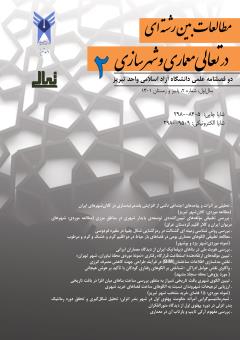تحلیلی بر اثرات و پیامدهای اجتماعی ناشی از افزایش بلندمرتبهسازی در کلانشهرهای ایران (مطالعه موردی: کلانشهر تبریز)
محورهای موضوعی : شهرسازی
ویدا حسینپور
1
,
حسین اصغری
2
![]() ,
علیرضا پورشیخیان
3
,
علیرضا پورشیخیان
3
![]() ,
سیده صدیقه حسنیمهر
4
,
سیده صدیقه حسنیمهر
4
![]()
1 - دانشجوی دکتری جغرافیا وبرنامهریزی شهری، واحد آستارا، دانشگاه آزاد اسلامی، آستارا، ایران
2 - استادیار گروه جغرافیا و برنامهریزی شهری، واحد آستارا، دانشگاه آزاد اسلامی، آستارا، ایران
3 - استادیار گروه جغرافیا و برنامهریزی شهری، واحد آستارا، دانشگاه آزاد اسلامی، آستارا، ایران
4 - استادیار گروه جغرافیا و برنامهریزی شهری، واحد آستارا، دانشگاه آزاد اسلامی، آستارا، ایران
کلید واژه: رشد جمعیت, پیامدهای اجتماعی, کلانشهر تبریز, بلندمرتبهسازی,
چکیده مقاله :
در عصر حاضر با توجه به افزایش فزایندهی جمعیت شهری و کمبود زمین خالی به اندازهی کافی برای ساختوساز، موجب توسعهی عمودی شهرها و بلندمرتبهسازی در ایران گردیده است. گرایش به بلندمرتبهسازی در شهرهای بزرگ ایران ضمن اثرات مثبت خود، دارای اثرات و پیامدهای زیانباری در ابعاد مختلف بهویژه بعد اجتماعی بوده است. در این راستا، هدف از پژوهش حاضر بررسی اثرات و پیامدهای اجتماعی ناشی از افزایش بلندمرتبهسازی در کلانشهر تبریز میباشد. روش تحقیق در پژوهش حاضر از نظر هدف کاربردی و به لحاظ ماهیت توصیفی-تحلیلی میباشد که در راستای تجزیه و تحلیل اطلاعات از روش حداقل مربعات جزئی در نرمافزار Warp-pls و آزمون F یا تحلیل واریانس استفاده شده است. جامعهی آماری تحقیق شامل شهروندان منطقه 1، 2 و 5 تبریز و به عبارتی ساکنان برجهای آفتاب در ولیعصر (منطقه 1)، برجهای آسمان در ائلگلی (منطقه 2) و برجهای مهر در شهرک رشدیه (منطقه 5) میباشد که در راستای تعیین حجم نمونه از روش کوکران استفاده شده و حجم نمونه 384 نفر تعیین گردیده است. یافتههای تحقیق نشان میدهد که مهمترین پیامدهای اجتماعی ناشی از بلندمرتبهسازی در کلانشهر تبریز مربوط به مؤلفههای اختلال در تعاملات اجتماعی، کاهش حس تعلق به مکان، اختلال در اجتماعی شدن، کاهش سلامت روحی-روانی و اختلال در حریم خصوصی بوده که ضرایب حاصل از مدل ساختاری برای هرکدام 651/0، 574/0، 433/0، 411/0 و 383/0 میباشد. همچنین در بین مؤلفههای فرعی نیز بیشترین تأثیرگذاری بلندمرتبهسازی مربوط به کاهش ارتباطات اجتماعی با دوستان و همسایگان، کاهش هویت مکان و حس تعلق مکانی و عدم شکلگیری مشارکت و اعتماد اجتماعی بین ساکنان بوده است.
In today's era, due to the increasing increase in urban population and the lack of enough empty land for construction, it has caused the vertical development of cities and high-rise construction in Iran. In addition to its positive effects, the tendency to build high-rise buildings in the big cities of Iran has had harmful effects and consequences in different dimensions, especially in the social dimension. In this regard, the aim of the current research is to investigate the effects and social consequences of the increase in high-rise construction in Tabriz metropolis. The research method in the current study is applied in terms of purpose and in terms of descriptive-analytical nature, in order to analyze the information were used partial least squares method in Warp-pls software and F test or analysis of variance. The statistical population of the research includes the citizens of the 1st, 2nd and 5th regions of Tabriz, that is, the residents of Aftab Towers in Valiasr (region 1), Asman Towers in El Goli (region 2) and Mehr Towers in Roshdieh town (region 5), which is in line with determining the sample size. Cochran's method was used and the sample size was determined to be 384 people. The findings of the research show that the most important social consequences of high-rise development in Tabriz metropolis are related to the components of disruption in social interactions, reduced sense of belonging to a place, disruption in socialization, reduction in mental health and disruption in privacy, which the coefficients obtained from the structural model are 0.651, 0.574, 0.433, 0.411 and 0.383 for each. Also, among the sub-components, the highest impact of high-rise development is related to the reduction of social connections with friends and neighbors, reduction of place identity and sense of place belonging, and lack of formation of participation and social trust between residents. The predictive power of the designed model is analyzed using the coefficient value for the dependent variables, values greater than or equal to 0.1 have been specified for the determination coefficient. Therefore, it was concluded that the structural model of the current research has sufficient power. In this model, 13.4% of the variance of the variables of social effects and consequences of high-ranking is justified by the variables entering it. Based on the Stone-Geyser test, because the values of the Geyser test are calculated to be higher than zero, it shows that the considered model has the necessary capacity and predictive power.Also, the comparative analysis of the studied towers based on the analysis of variance method shows that there is no significant difference between the social consequences caused by high-rise construction between these towers. Variance analysis test is used to measure the difference between the average of a variable in more than two groups (3 groups and more). According to the amount of F statistic with 22.321 and a significance level of less than 95%, the obtained results indicate that there is no significant difference between the selected indicators in the current research between the towers under study.
_||_


